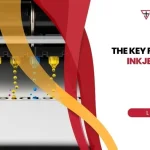Streamline Your Knowledge: What It Means to Simplify Processes
What does streamline process mean for today’s business owners? At its core, streamlining a process means simplifying tasks and eliminating unnecessary steps to improve efficiency, making workflows more effective and easier to manage.
Here’s what streamlining actually involves:
- Removing redundant steps that waste time and resources
- Automating repetitive tasks to reduce human error
- Standardizing procedures for consistent outcomes
- Eliminating bottlenecks that slow down operations
- Optimizing workflows to maximize productivity
The numbers tell a stark story. Research shows that 72% of small business owners already feel overwhelmed, while employees spend a staggering 58% of their days doing “work about work” – switching between apps, chasing down information, and handling administrative tasks that don’t directly contribute to business goals.
Picture this: Imagine moving around in a cluttered workspace with stacks of papers everywhere, tools scattered about, and no clear path from point A to point B. Frustrating, right? Now, picture the same workspace as clean, organized, and efficient, where every item has its place, and everything runs like a well-oiled machine. That’s the change streamlining brings to your business processes.
For retail business owners facing outdated systems and rising operational costs, streamlining isn’t just about efficiency – it’s about survival and growth in an increasingly competitive marketplace. When done right, it frees up your team to focus on what matters most: serving customers and driving revenue.
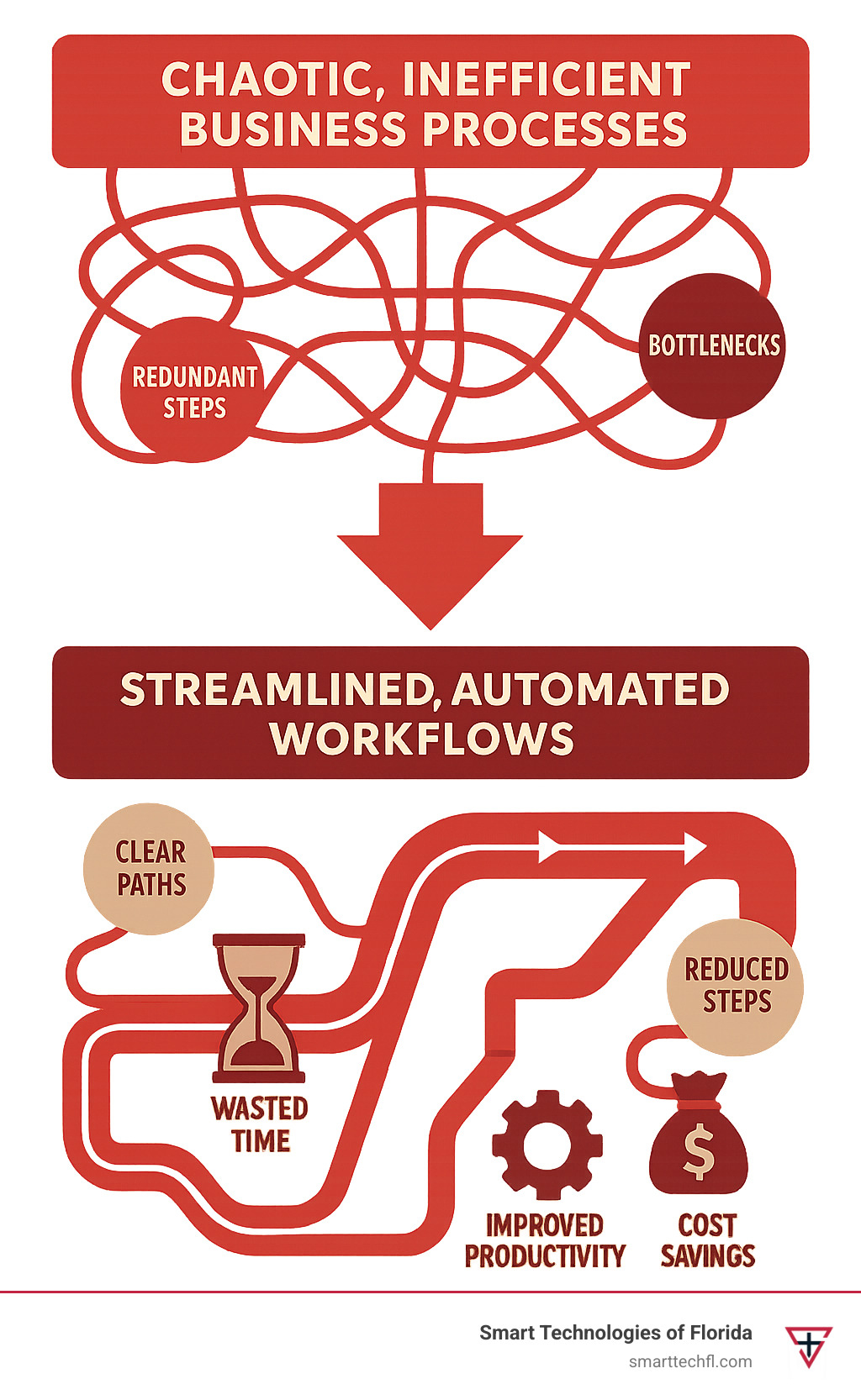
What Does Streamline Process Mean in Practice?
So, you’re asking, what does streamline process mean in the everyday hustle of running a business? Simply put, it’s about making your daily operations smoother, cleaner, and less complicated. It’s not just about doing things faster; it’s about doing them smarter and better. This means looking at every step of how work gets done to simplify or remove anything that doesn’t add value. The goal is to achieve both efficiency (doing things right) and effectiveness (doing the right things) for real, noticeable improvements.
For more insights into how this translates to your business, explore our guide on More info about Streamlining Business Processes.
The Core Benefits: More Than Just Saving Time
The impact of streamlining your processes creates a ripple effect of benefits:
- Increased Productivity: By eliminating “busywork,” your team can focus on tasks that truly add value, boosting overall output.
- Reduced Operational Costs: Automating tasks, cutting manual effort, and using resources smarter saves money on everything from supplies to labor.
- Improved Quality and Consistency: Standardized processes reduce the chance for mistakes, leading to more reliable and consistent outcomes.
- Improved Customer Satisfaction: Smoother internal operations mean faster, more reliable service, which leads to happier, more loyal customers.
- Higher Employee Morale: Removing frustrating, repetitive tasks empowers your team to focus on more fulfilling work, increasing job satisfaction.
- Minimized Risk: Clear, documented processes improve compliance and reduce the chances of costly errors or data breaches.
- Improved Accountability & Simplified Training: With defined processes, everyone knows their roles, making it easier to track progress and onboard new team members. Streamlining helps you achieve true operational excellence.
Real-World Examples of Streamlined Processes
To truly grasp what does streamline process mean, here are some real-life examples:
- Automating Employee Onboarding: Instead of manual paperwork, new hires can complete forms digitally, and system access can be granted automatically.
- Simplifying Invoice Processing: Using online payment systems and centralizing supplier information reduces errors and speeds up payments.
- Centralizing Customer Support Tickets: A single system logs, routes, and tracks all customer inquiries, ensuring faster responses and happier customers.
- Streamlining Supply Chain Logistics: Automating inventory and linking supplier data can cut storage costs and speed up delivery.
- Automating Marketing Follow-ups: Use automation to send follow-up emails or update customer records based on user actions, nurturing leads without manual effort.
- Digitalizing Financial Reporting: Give managers real-time budget dashboards instead of relying on manual reports from the finance team.
- Automating Expense Approvals: A digital workflow for expense approvals cuts down on errors and speeds up reimbursements.
The 3-Step Blueprint for Effective Streamlining
Starting on a streamlining journey is a manageable process with this clear, three-step blueprint. It’s a systematic approach to identify bottlenecks, redesign workflows, and ensure continuous improvement.
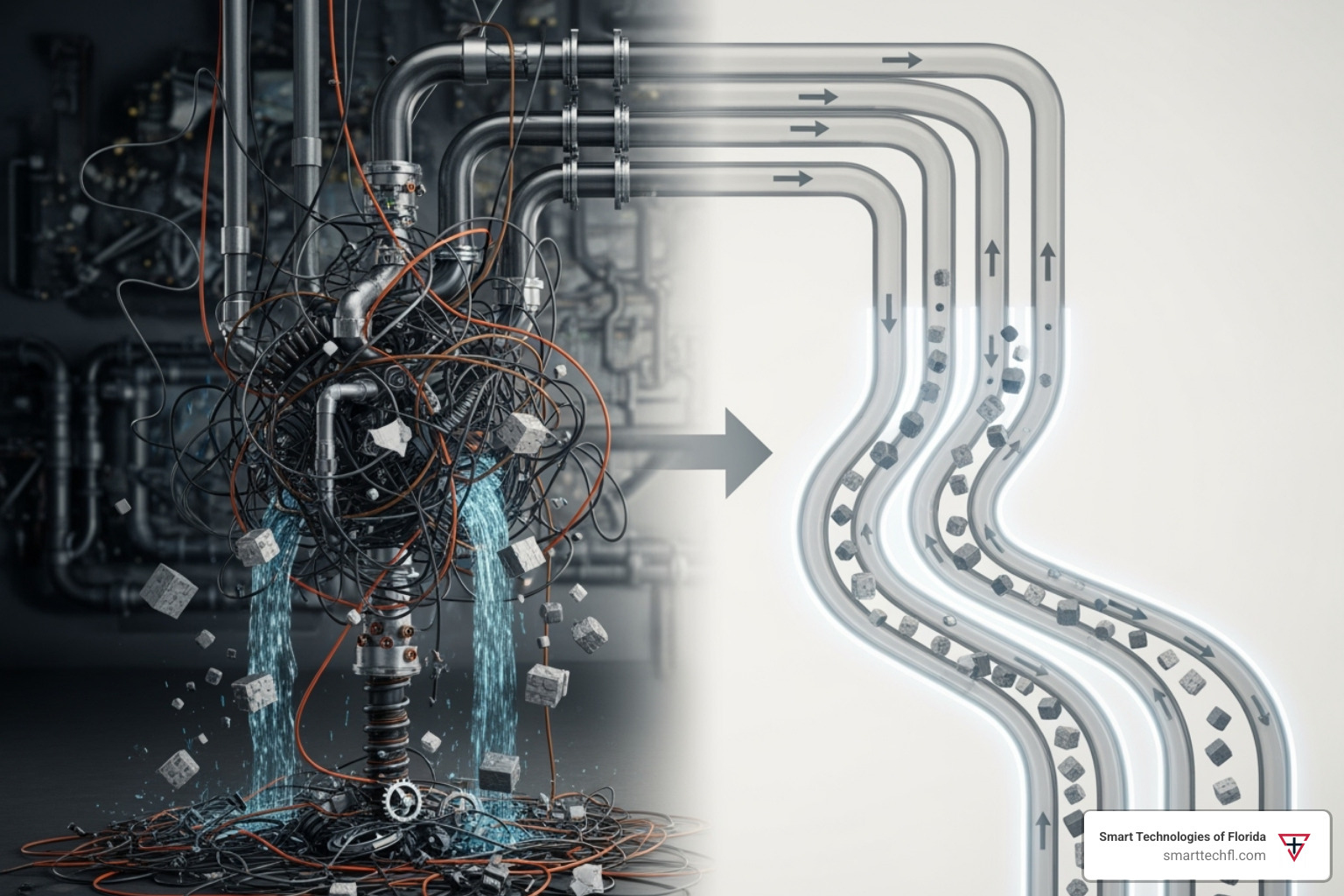
Step 1: Analyze and Identify Opportunities
Before you can improve a process, you must understand it. This phase is about investigating your current workflows to find opportunities for optimization.
- Assess Current Processes: Map out your existing workflows from start to finish. Identify every step, who is involved, and what the goal is. This helps spot redundant tasks and unnecessary steps.
- Gather Employee Feedback: Your team is on the front lines and has invaluable insights. Use surveys, meetings, and one-on-one conversations to understand their pain points and ideas for improvement.
- Prioritize High-Impact Areas: You can’t fix everything at once. Rank processes based on their impact on costs, productivity, and customer satisfaction to focus your efforts where they matter most.
- Use Analytics to Find Inefficiencies: Data reveals the truth. Analyze metrics like task completion times, error rates, and resource usage to pinpoint the root causes of bottlenecks. This data-driven approach ensures you’re solving the right problems. To dig deeper into this crucial first step, explore our insights on how to Streamline Workflow Processes: Key Steps.
Step 2: Redesign and Implement with Technology
With a clear understanding of the issues, it’s time to design and implement better workflows, often with the help of technology.
- Standardize Tasks: Create clear, consistent procedures and templates for recurring tasks. Standardization reduces errors, simplifies training, and ensures reliable outcomes.
- Automate Repetitive Work: Identify manual, rule-based tasks and automate them. This frees up your team to focus on more strategic, high-value activities.
- Implement New Software: Use tools like CRM, BPM, or project management software to centralize data, automate steps, and gain visibility into your operations.
- Test New Workflows: Before a full rollout, run a pilot test with a small group to work out any kinks and gather feedback.
- Train Your Team: Ensure everyone understands the new process and the “why” behind it. Proper training is crucial for successful adoption and overcomes resistance to change. Learn more about how we can help with Business Process Automation.
Step 3: Monitor, Refine, and Improve Continuously
Streamlining is not a one-time project but an ongoing cycle of improvement.
- Track Key Performance Indicators (KPIs): Measure the impact of your changes against predefined goals, such as reduced costs or faster cycle times.
- Solicit Ongoing Feedback: Continuously gather input from employees and customers to identify new areas for improvement.
- Make Iterative Adjustments: Use data and feedback to make small, regular adjustments. The goal is continuous progress, not a one-time fix.
- Foster a Culture of Improvement: Encourage everyone in the organization to always be looking for ways to make things better. This mindset, often called Kaizen, ensures your business remains agile and efficient.
Methodologies and Tools That Drive Efficiency
Achieving a truly streamlined business isn’t just about wishing for things to be better; it’s about having a clear plan and the right tools in your toolkit. In business, we have proven methodologies and incredible technology to guide us. Together, these can profoundly transform how your operations hum along, truly showing you what does streamline process mean in practice.
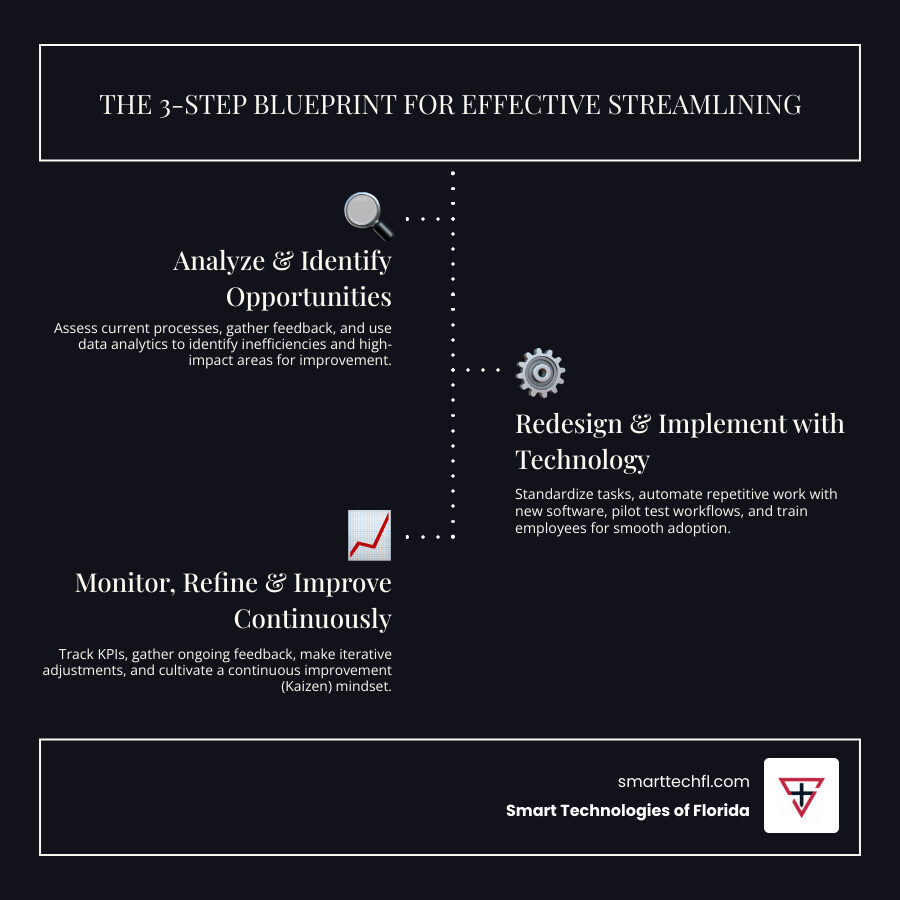
Key Methodologies to Guide Your Efforts
Established methodologies offer structured ways to analyze, improve, and manage your operations. Each one helps you answer what does streamline process mean through a different lens.
| Methodology | Core Principle & Focus – |
|---|---|
| Lean | Focuses on maximizing customer value while minimizing waste. It’s about creating more value with fewer resources. Learn more about the core ideas of Lean. |
| Six Sigma | A data-driven approach that aims to eliminate defects and variability in processes, ensuring consistent, high-quality output. |
| Agile | Emphasizes flexibility and iterative progress. Work is broken down into small, manageable increments, allowing for continuous feedback and adaptation. |
The Role of Technology: What does streamline process mean in the digital age?
Technology is the engine that powers modern streamlining. It automates repetitive tasks, provides real-time insights, and connects your entire organization.
- Business Process Management (BPM) software helps you map, analyze, and track improvements.
- Automation platforms handle routine tasks, freeing up your team for strategic work. Our guide on Automation Tools for Business: 8 Must-Haves explores the most impactful tools available today.
- AI-powered assistants can analyze data, predict problems, and suggest process improvements.
- Low-code and no-code platforms allow non-technical team members to create their own workflow solutions.
- Document management systems centralize files and automate version control. Learn more about how Document Management can transform your operations.
- Cloud-based collaboration tools break down silos and enable seamless teamwork, regardless of location.
The key is choosing technology that solves real problems. The best tools make work easier and more efficient, empowering your people to achieve strategic goals.
What Does Streamline Process Mean in Practice?
When we ask what does streamline process mean, the simplest answer is this: make work flow smoothly so people and technology can deliver results faster and with fewer headaches. Streamlining focuses on two goals:
- Efficiency cutting out wasted effort and resources.
- Effectiveness ensuring every remaining step actually creates value.
For a deeper dive, see our guide on streamlining business processes.
The Core Benefits (Short List)
- Productivity up, busywork down
- Lower operational costs through automation and standardization
- Consistent quality that boosts customer trust
- Happier employees who spend time on meaningful tasks
- Reduced risk & simplified compliance
These gains form the backbone of operational excellence.
Quick Real-World Examples
- Automated employee onboarding
- Digital invoice processing that posts, approves, and schedules payment automatically
- Centralized customer support tickets for faster resolutions
- Inventory tools that reorder stock before you run out
- Auto-triggered marketing follow-ups that keep leads warm
Each example shows how removing friction frees people to focus on high-value work.
The 3-Step Blueprint for Effective Streamlining (Concise Version)
A proven, lightweight framework keeps your initiative focused and manageable.
Step 1 Analyze & Pinpoint Bottlenecks
- Map the current workflow end-to-end.
- Collect frontline feedback and data (time, cost, error rate).
- Prioritize the handful of processes that have the biggest impact. More detail in our post on key steps.
Step 2 Redesign with Technology
- Standardize the “happy path” with clear templates or checklists.
- Automate repetitive or rules-based tasks.
- Introduce supportive software (BPM, CRM, RPA, etc.) and pilot it with a small team.
- Train employees so they understand both the how and the why. Explore our options for Business Process Automation.
Step 3 Monitor & Improve Continuously
- Track a handful of KPIs (cycle time, cost per transaction, error rate).
- Gather ongoing feedback from staff and customers.
- Iterate: small tweaks beat massive once-a-year overhauls.
- Foster a culture where everyone looks for the next 1% gain.
Follow this cycle, and streamlining shifts from a one-off project to a permanent competitive advantage.
Methodologies and Tools That Drive Efficiency
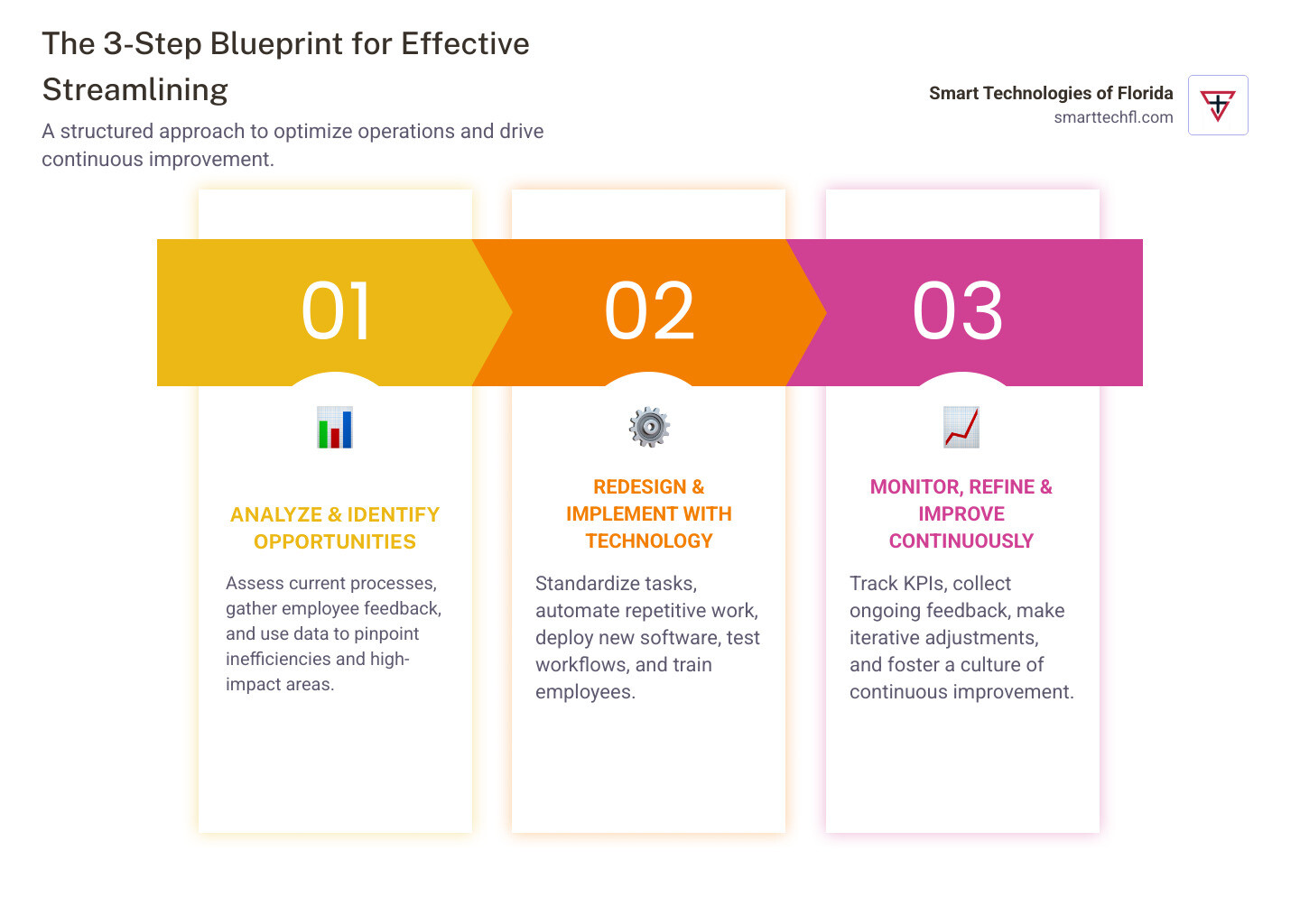
Popular Improvement Playbooks (Side-by-Side)
| Methodology | Core Focus |
|---|---|
| Lean | Remove waste and deliver more value with fewer resources. |
| Six Sigma | Use data to reduce defects and process variation. |
| Agile | Deliver work in small, iterative increments for rapid feedback and adaptation. |
Technology: The Accelerator
Modern tools reveal what streamline process mean in a digital world:
- Business Process Management (BPM) visualize workflows and track improvements.
- Automation platforms trigger, route, and complete routine tasks. See our list of 8 must-have tools.
- AI assistants surface insights and predict issues before they derail projects.
- Low-code / no-code builders let non-developers create custom workflows quickly.
- Document management systems centralize files and automate version control. Learn more about Document Management.
- Cloud collaboration suites keep distributed teams aligned in real time.
Choose technology that solves a real bottlenecknot because its trendyand youll see immediate, measurable gains.








